What is it?
Danelectro DJ5 Tuna Melt Tremolo from Dano’s mini effects series.
This is one of those that should not be overlooked no matter what opinion you may have about the box/jacks/switch/whatever. Definitely one of the best and most desired boxes in the mini series in addition to Chicken Salad and a few other units. This will always have much more of user than collector value. Opening the bottom plate reveals the basic electronic switching board, common to the mini series effects.
But taking that lower board off reveals the effect board. As always, the pots are just bigger trimmers with knobs attached to them, Hard/Soft switch is your standard submini on-on and so on. But wait. What’s the black blob next to lower opamp? Analog optoisolator (or also known as vactrol)!
So it is optical tremolo and it sounds like it. There are a few different ways to create good tremolo effect. Using analog optoisolator is one of the best. Optoisolators consist of two parts, the LED and LDR. LFO pushes the LED part to blink, which alternates the resistance of the LDR according to LFO speed. Which then causes the signal to go up and down in amplitude. Like i said, there are other good ways too. Here we have two TL072s for the modulation mixer amp and LFO driver. The modulation is applied to inverting input of the amplifier.
Quite simple design, now that i think of it. Mr. Clay Jones has drawn a traced schematic back in 2005. Found on FSB, here. The schematic shows that there are two switchable LFO wave forms. Other uses one half of other opamp and other has a transistor for faster decay.
Soldering work looks like the person soldering the components doesn’t really care for his/her job. Looks quite bad actually. Sad thing, but what do you expect from pedals in this price range?
I’ll post one more shot of the traces. Those looks pretty neat now don’t they!
Edit: The design has a “flaw” that i’ve run into earlier, but for some reason i’ve dismissed it. The depth control works only for the soft setting of the LFO wave switch. The control does nothing when the hard mode is engaged. The schematic mentioned above will confirm this.There’s no chance the depth control will do anything when using the hard mode. Also, i’ve seen photos with Tuna Melt units with three knobs instead of two and the switch, but i’ve never seen an actual unit with three knobs. I think there will be more updates to this post at some point…
How does it sound?
Very good. Both controls, depth and speed have a wide variety of useful stuff on the sweep. It sounds very mellow and soft, even with hard settings switched. Not as choppy as it could be, but this is still very nice tremolo. If you can score one for cheap – go for it.

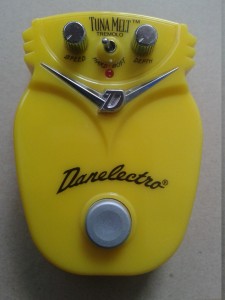
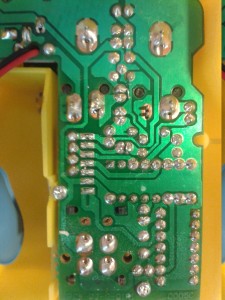
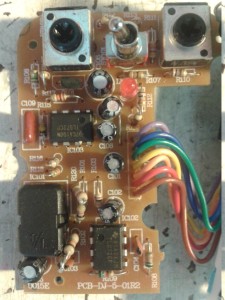
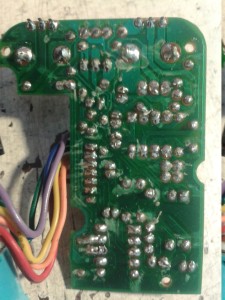
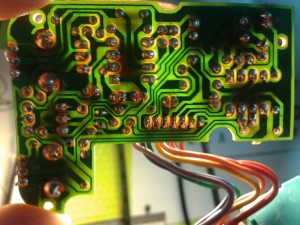
This is a cool little pedal, and I got mine new for about $13 from a local music shop. I really did want a trem with continuous variable waveform and depth, but per the good reviews and the cheap price, I said “Pluck that duck! What have I got to lose?” ~ But I’m curious…. is it possible to mod my switch version to be like to older 3 knobber one with the variable waveform? And in that, could the depth control actually work with the square wave trem? Or is it not worth the trouble to hack the little guy? —- Great blog, btw !!!! Well done :-))))
Anything’s possible, but the mod you suggest isn’t exactly easy task. Check the schematic for LFO part and you’ll know what i’m talking about..
+m
If you could clarify, referring to the earlier post, do you know if the 3-knob version is in fact the older version, or was it an attempt to fix the design flaw you mention? Not to rely too much on the online images, but a lot of the new ones I see being sold use the image of the 3-knob version. Do you know if they are otherwise the same? Thanks!
Actually, i can’t since my assesment is based on an assumption.
Since the picture of three knobbed version was featured in Dave Hunter’s Guitar Effect Pedals, practical handbook (bad book by the way), which was released in mid 2004, my assumption is that the three knobber must be an earlier version due to that promotional photo being taken between 1999 and 2003. Also, on the photo above, there is a PCB designation of PCB-DJ5-01R2, which could be translated as year 2001 and revision 2. Again, this is also based on an assumption. On the other hand i have never seen the three knob version in real life. Which means that i can’t be completely certain if there was a version before this possible revision 2, or if the three knob version is later one. Timeline suggests my assumption could be correct, but it is still nothing more but an assumption.
If any of you have solid proof, i’d be more than happy to revise my take on the model’s history.
+m
Hi just wondering if you experience the same volume drop problem on the tuna melt as mine when the pedal is engaged?
No, i don’t recall noticing any drop on mine. If you find the schematic (the link is dead), you could up the value of R113 a bit. That should fix it.
+m
Hello! Nice write up.
I thought I would add to the discussion about the model revision. My Tuna Melt was bought in 1999 and is the two knob version, with ©1999 on the baseplate sticker as well as PCB-DJ-G-01R1 and 0005C on the green lower board. The brown board has DJ-5-01R1 on it along with 0005B.
I think the 3 knob pedals,if they actually exist, are the newest of the bunch.
I also love my Tuna Melt. I got it dirt cheap at a flea market. It was not working (seller didn’t mention that) but it was only bad solder joints so it was easily fixed.
The thing with the three knob version: here is a picture https://www.musikland-online.de/Danelectro-DJ-5-Tuna-Melt/
It only says hard/soft beneath the knob. I also own the cool cat tremolo which has the same vactrol. Maybe it is very close if not the same as the tuna melt. The point is it has also three knobs that look like potentiometers but one is a switch. Could be the same in the three-knobbed tuna.
Thanks mirosol for your articles.